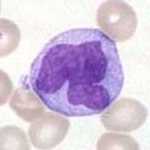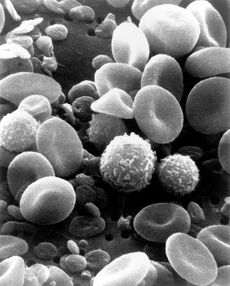Assessment |
Biopsychology |
Comparative |
Cognitive |
Developmental |
Language |
Individual differences |
Personality |
Philosophy |
Social |
Methods |
Statistics |
Clinical |
Educational |
Industrial |
Professional items |
World psychology |
Biological: Behavioural genetics · Evolutionary psychology · Neuroanatomy · Neurochemistry · Neuroendocrinology · Neuroscience · Psychoneuroimmunology · Physiological Psychology · Psychopharmacology (Index, Outline)

Monocyte
A monocyte is a leukocyte, part of the human body's immune system that protects against blood-borne pathogens and moves quickly (approx. 8–12 hours) to sites of infection in the tissues. Monocytes are usually identified in stained smears by their large bilobate nucleus.
Physiology[]

Monocyte
Monocytes are produced by the bone marrow from haematopoietic stem cell precursors called monoblasts. Monocytes circulate in the bloodstream for about one to three days and then typically move into tissues throughout the body. They constitute between three to eight percent of the leukocytes in the blood. In the tissues monocytes mature into different types of macrophages at different anatomical locations.
Monocytes are responsible for phagocytosis (ingestion) of foreign substances in the body. Monocytes can perform phagocytosis using intermediary (opsonising) proteins such as antibodies or complement that coat the pathogen, as well as by binding to the microbe directly via pattern-recognition receptors that recognize pathogens. Monocytes are also capable of killing infected host cells via antibody, termed antibody-mediated cellular cytotoxicity. Vacuolization may be present in a cell that has recently phagocytized foreign matter.
Monocytes which migrate from the bloodstream to other tissues are called macrophages. Macrophages are responsible for protecting tissues from foreign substances but are also suspected to be the predominant cells involved in triggering atherosclerosis. They are cells that possess a large smooth nucleus, a large area of cytoplasm and many internal vesicles for processing foreign material.
Diagnostic use[]

A scanning electron microscope (SEM) image of normal circulating human blood. One can see red blood cells, several knobby white blood cells including lymphocytes, a monocyte, a neutrophil, and many small disc-shaped platelets.
A monocyte count is part of a complete blood count and is expressed either as a ratio of monocytes to the total number of white blood cells counted, or by absolute numbers. Both may be useful in determining or refuting a possible diagnosis. Monocytosis is the state of excess monocytes in the peripheral blood. It may be indicative of various disease states.
Examples of processes that can increase a monocyte count include:
- chronic inflammation
- stress response
- hyperadrenocorticism
- immune mediated disease
- pyogranulomatous disease
- necrosis
- red cell regeneration
Dendritic cells[]
Monocytes can be used to generate dendritic cells in vitro. [How to reference and link to summary or text]
See also[]
- Agranulocyte
- Complete blood count
- Hematopoiesis
- Neutrophil granulocyte
- Phagocyte
- White blood cell
External links[]
- Histology at Boston University 01702ooa
- Human Monocytes - Prof. Dr. Ziegler-Heitbrock
Blood | |
|---|---|
| General |
Plasma - Hematopoietic stem cells |
| Lymphoid - WBC |
T cells: Cytotoxic CD8+, Helper CD4+/Regulatory, γδ, Natural Killer T cell |
| Myeloid - WBC |
Granulocytes (Neutrophil, Eosinophil, Basophil) - Mast cell precursors |
| Myeloid - RBC |
Reticulocyte - Normoblast |
Immune system / Immunology / Psychoneuroimmunology
| |
|---|---|
| Systems | Adaptive immune system vs. Innate immune system • Humoral immune system vs. Cellular immune system • Complement system (Anaphylatoxins) |
| Antibodies and antigens | Antibody (Monoclonal antibodies, Polyclonal antibodies, Autoantibody) • Allotype • Isotype • Idiotype • Antigen (Superantigen) |
| Immune cells | White blood cells (T cell, B cell, NK cell, Mast cell, Basophil, Eosinophil) • Phagocyte (Neutrophil, Macrophage, Dendritic cell) • Antigen-presenting cell • Reticuloendothelial system |
| Immunity vs. tolerance | Immunity • Autoimmunity • Allergy • Tolerance (Central) • Immunodeficiency |
| Immunogenetics | Somatic hypermutation • V(D)J recombination • Immunoglobulin class switching • MHC / HLA |
| Other | Cytokines • Inflammation • Opsonin |
| This page uses Creative Commons Licensed content from Wikipedia (view authors). |